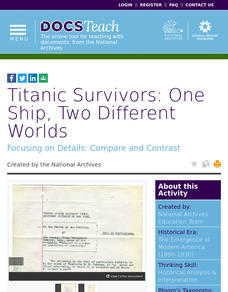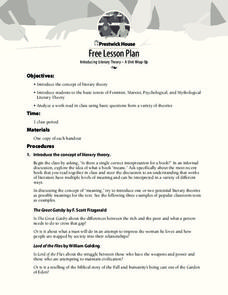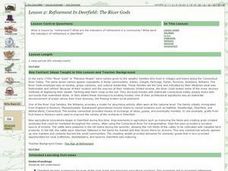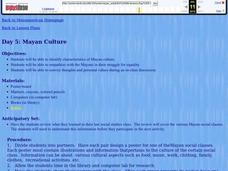Learning for Justice
Cliques in Schools
Band geeks, jocks, preppies; every school has its groups. Middle and high schoolers identify the various friendship groups and cliques in their school and consider these groups' positive and negative traits. After completing a Clique...
National First Ladies' Library
Women's Lives in the Victorian Era
The lives of middle-class Victorian women were circumscribed by strict standards that governed all aspects of behavior. To gain a better understanding of the Victorian Ideals for women, class members research the life of a middle-class...
Nebraska Department of Education
Social Class and Fitting In
Social classes may be explicitly defined as in a caste system or based more informally on such ideas as wealth or education. After reading and discussing an article about one woman's experience with trying to fit into a system different...
National Endowment for the Humanities
Language Analysis Based on Stave 1
Class members meet the original scrooge, the Dickens character whose name has become synonymous with a cold-hearted, tight-fisted, miser. Using the provided worksheet, readers closely examine context clues to determine the meanings of...
Simon & Schuster
Curriculum Guide to: Pride and Prejudice by Jane Austen
An 18-page curriculum guide for Jane Austen's Pride and Prejudice consists of five lessons. The first plan asks readers to compare the manners, social behaviors, and class issues in Austen's novel to today's. Next, pupils examine a...
DocsTeach
Titanic Survivors: One Ship, Two Different Worlds
Scholars explore claims from two Titanic survivors, a first-class passenger and a person from the steerage class. The activity uses primary documents to help pupils determine whether the White Star Line showed preferential treatment to...
Smithsonian Institution
Borders and Community: Early 20th Century Chicago Neighborhoods and Ethnic Enclaves
Chicago is one city, four neighborhoods, and countless nationalities. The instructional activity explores the ethnic division of Chicago in the early twentieth century. Academics read primary sources, analyze maps, and tour an online...
Teaching Ideas
The Victorians Pack
What was life like during the Victorian era? Images of crowded factories and lavish palaces may come to mind—and both would be accurate. Learn more about Britain during the 64-year reign of Queen Victoria with a series of informational...
iCivics
Step Three: Who You Gonna Call?
Problem solving is an essential skill everyone must master. The resource instructs pupils how to analyze different scenarios and decide the best way to solve many different problems that take place in communities. Scholars read, discuss,...
Prestwick House
Introducing Literary Theory – A Unit Wrap-Up
Literary theories are lenses through which a text may be analyzed. The question in this lesson plan is how a particular literary lens can influence the reader's view of the text.
Novelinks
Wuthering Heights: Concept/Vocabulary Analysis
New to using Bronte's Wuthering Heights in the classroom; check out this overview of themes, characters, settings, and project suggestions.
Student Handouts
Blank Pyramid Charts
From feudal societies to European monarchies, a blank pyramid template can support your learners in understanding social hierarchies and distinctions between classes.
Student Handouts
Medieval Life Chart
What were the benefits and drawbacks of being a serf/knight/lord/lady/king/queen/etc. in the Middle Ages? Consider all the comparisons with your young historians using this graphic organizer.
Curated OER
A Sense of Community
First graders engage in this interesting series of lessons about community. They view images of communities of people working and playing together, and come up with their own piece of artwork that reflects their sense of community at...
Curated OER
Social Class Stereotypes
Encourage your learners to think about how and why people and categorized in terms of social class. They decide what "class" they belong to, and then brainstorm about the indicators that society uses to define class and to categorize...
National Endowment for the Humanities
The "Secret Society" and FitzGerald's The Great Gatsby
"I have never been able to forgive the rich for being rich, and it has colored my entire life and works." This colored view is the focus of a close reading activity that asks readers of The Great Gatsby to examine the way...
Curated OER
Design Life: Exploring Society Through Art
Introduce learners to the design elements and artifacts of interior environments in Victorian Canada (or any people and era you care to explore) based on artwork that represents their world. Your secondary social historians view the art...
Curated OER
The Real Monopoly: America's Racial Wealth Divide
Students explore America's racial wealth divide. In this Teaching Tolerance instructional activity, students play a "rigger" version of the game Monopoly and reflect on the game and economic injustice in the United States.
Curated OER
A Changing Society: Industrialization and Urbanization
Students participate in activities that teach them about the Gilded Age of industrialization and urbanization. In this social changing lesson plan, students answer questions, watch videos, have discussions, read texts, and more to teach...
Curated OER
Refinement in Deerfield: The River Gods
Students research the town of Deerfield, CT and its River God families to show how the middle class developed in the Connecticut River Valley.
Curated OER
We and Thee
Learners examine class structure. In this diversity education instructional activity, students discuss stereotypes within their school as an introduction to Shakespeare's Romeo and Juliet. After learners have read the play and discussed...
Curated OER
Mayan Culture
Learners examine the attributes of the Mayan culture. In this Mayan culture instructional activity, students identify the structure of social classes in Mayan society and design posters that feature their findings.
Curated OER
Chapter 9: Social Stratification
In this social stratification worksheet, learners answer 12 fill in blank questions and 7 multiple choice questions regarding the division of society into categories.
Curated OER
Social Class, Social Change, and Poverty
Students begin to explore poverty and its implications on society and future generations. They should have had experience with identifying social change that happens gradually and social change that happens quickly because of natural...

























